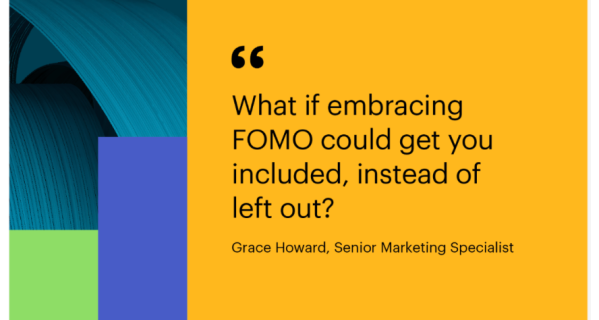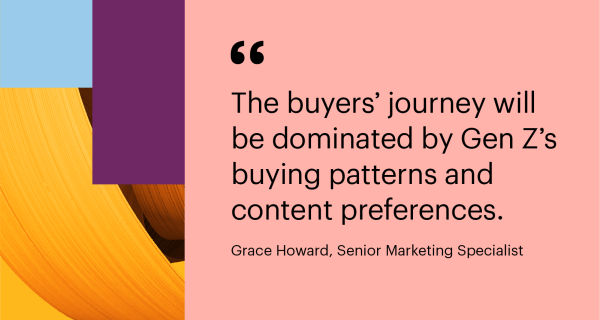One of the worst feelings is when you try something new – whether it be a restaurant, movie, or product – and it just doesn’t live up to your expectations.
This is especially true in B2B marketing and sales. It’s extremely frustrating when a shiny new software, tool, or strategy your team pushed for can’t prove any ROI and isn’t living up to your organization’s expectations.
While we hope your ABM journey has been smooth sailing for you, we know that isn’t always the case. Like any strategy, account-based marketing might not be perfect the first go around. So here are 4 reasons why ABM might not be living up to your expectations, with solutions you can put into action.
Reason #1: Marketing and sales silos
ABM is a team effort and is supposed to align your marketing and sales teams. In fact, Foundry ABM client Clearwave was able to see a 20% reduction in time to close by fostering an aligned sales and marketing strategy. However, we see some organizations still operating in silos even after implementing ABM. Studies have shown failure to align your marketing and sales teams can cost B2B companies revenue slippage of anywhere up to 10%.
So why do some organizations struggle to work in tandem with each other after implementing ABM? There could be a variety of reasons including:
- Unclear goals
Once ABM is adopted, marketing and sales teams should align goals with an account-based approach. For example, maybe set a goal to decrease sales cycles by x%. This will encourage marketing to work with sales to understand what personalized content a specific account might need for 1:1 outreach. Sales can then accelerate conversions by using these insights and resources to keep prospects engaged throughout the entire purchase journey.
- Lack of communication
Sometimes the root of the issue is a bit more simple – sales and marketing don’t communicate enough. This can start at the leadership level if marketing and sales leaders are not on the same page, or this can come down to a lack of time for collaboration. A large benefit of ABM is that sales teams have less busy work, as sales only targets accounts most likely to convert. Marketing can use account insights to select a winning play for sales – all the more reason for communication to take place!
- Failure to adopt account-based metrics
Once ABM is implemented, marketing and sales teams must reconsider the metrics they use to measure success. ABM is different from traditional tactics, so it must be measured differently too. Before even launching an ABM program, marketing and sales leadership should align on how they’ll define qualified accounts and attribute revenue to the ABM program. Failure to define qualified accounts and shift to ABM reporting can lead to a division among marketing and sales teams.
No matter what ABM platform you use, organizations that operate with siloed marketing and sales teams will struggle to implement an ABM program successfully.
Solution
Here are two strategies to unite your siloed marketing and sales teams and set your organization up for ABM success.
- Align goals
Goals set for both marketing and sales must be aligned. Marketing and sales working towards the same goal will help to align them on the same page and encourage collaboration. Have leadership reevaluate what KPIs each team is measured on and identify a common goal to be accomplished through ABM implementation.
- Open a line of communication
Create conversation! Providing your marketing and sales teams with an open line of communication will allow for collaboration and feedback among teams. Marketing can inform sales on specific insights and high-intent accounts, while sales can inform marketing on what content prospects want and what’s working or not. To encourage communication we recommend setting up weekly or biweekly team syncs or creating a dedicated slack channel.
Reason #2: Poorly defined ICP
The first step in any ABM campaign is to start with a list of strategic target accounts. But how do you build that list of accounts?
Start with your Ideal Customer Profile!
An ICP (ideal customer profile) is the foundation of any ABM strategy. ICP is the hypothetical description of the type of buyers in your market that would benefit most from your product or service. Detailed in the ICP are important pieces of information such as target account personas, pain points, and the value proposition.
Since every ABM campaign starts with a list of accounts built from your ICP, it would make sense that problems arise if you are working with a poorly defined ICP.
Solution
Here are our tips for workshopping your ICP in order to build a strong ABM foundation,
Try answering these questions to get an idea of the kind of accounts you should be targeting, or better yet, reference your actual CRM data for ultimate accuracy in your ICP definition.
How would you describe your ideal account?
- Industry (Healthcare, Software, Education)
- Geography (US, Canada, EMEA, APAC)
- Size (SMBs, Large Enterprises)
- Budget (How large of a budget does this organization have to spend on software or tools?)
How would you describe your ideal persona?
- Department (Marketing, Sales, Operations)
- Seniority (Entry Level, Manager, C-suite)
- Job Titles
- Responsibilities and Objectives
What are their key drivers?
- Pain Points
- Influencers (Who are the decision makers?)
- Channels (What channels would resonate most with this account?)
- Timing (When should we reach out?)
Want a full template on how to workshop your ICP for ABM? Download this free template.
Reason #3: Not utilizing your full tech stack
In order to get the most out of your ABM program, you’ll want to make sure that you are using the existing tools in your martech stack and any available integrations.
Occasionally we see organizations purchase an ABM platform thinking it will be a shiny tool to fix all their issues. However (as you probably know), it’s not that simple.
It’s extremely important to do research before purchasing an ABM platform (or any piece of technology). Talk to ABM vendors to see what integrations they offer. Does the platform integrate with any technology you already own? Will you have to buy additional bells and whistles along with the platform? These are questions that must not be overlooked when deciding what ABM platform will fit best into your existing tech stack.
Solution
Here are a few tools that we recommend having in your tech stack in order to best run your ABM program.
- Intent Data
Intent data gives you insights into your buyer’s activities across the web. When these insights are integrated into your ABM platform, you can automatically trigger sales plays and alerts based on intent signals. Here are a few examples of intent providers that work with Foundry ABM:
- Foundry Intent: Identify intent across your website, the public web, industry content, and Foundry’s opted-in audience to provide a more meaningful view of in-market buyer behavior.
- Bombora: Account-level intent data determined from research activity across thousands of B2B websites.
- G2 Intent: Account-level intent data from activity on the G2 product review site.
- Marketing Automation
Marketing Automation tools like HubSpot, Marketo, and Pardot integrate into Foundry ABM’s platform allowing you to automate tactics and pass lists of leads or accounts into ABM campaigns and reports. Integrating ABM platforms with channels used for advertising and marketing automation platforms allows for even better reporting and orchestration – creating seamless stage progression among accounts.
Foundry ABM has the best HubSpot integration out of all the ABM providers. It is two-way, simple to set up, easy to use, and automated.
Marketing Manager, IT Industry
- CRM Platforms
Sync your CRM with your ABM platform to support list building, predictive scoring, ROI reporting, and prioritizing accounts for sales. Sales teams should be able to action on sales activations and intent data from within their CRM. This saves times for your sales reps as all the insights they need are in one place – providing them information on when and who to reach out to, and what to say.
Tech Stack Success
SugarCRM has perfected the tech stack element of ABM. Sugar leverages the Foundry ABM platform, Bombora Surge Topics, and G2 intent data signals to identify in-market accounts early and galvanize sales and marketing to discover pipeline as one team. Since doing so, Sugar has generated $9.9M in influenced pipeline attribution from their ABM efforts, with an estimated $2.8M in the first quarter alone.
Reason #4: Failure to adopt account-based KPIs
Since ABM is different than traditional demand generation tactics, it requires a different way of measuring metrics throughout the buyer’s journey. While typical demand generation focuses more on quantity, ABM focuses on quality. By adopting account-based KPIs, you’ll be able to better understand the benefits and value that ABM brings to your organization. Taking an account-based approach to metrics will help to measure ROI from ABM and help you continue to make the case for ABM.
Solution
We’ve helped marketers execute thousands of ABM campaigns and have learned a metric or two along the way. Here are a few account-based metrics that we recommend you use when measuring ABM.
- Reach
Reach is defined as the percentage of target accounts touched by your campaigns. Key metrics for reach include ad impressions or email opens.
- Engagement
Engagement is defined as a percentage change in interactions with target accounts. Key metrics include website visits or email campaign responses.
- MQAs
MQAs are defined as the number of highly engaged accounts prioritized for sales engagement.
- Pipeline
Pipeline is defined as the dollar value of deals opened in target accounts. The key metric to measure pipeline success is new opportunities.
- Return On Investment (ROI)
ROI is defined as the dollar value of deals closed-won in target accounts. The key metric to measure ROI is closed deals. Learn how to calculate your ROI for ABM in this article.

If you fail to change the way you measure marketing and sales success with ABM – this could be a large reason ABM is not living up to your expectations.
Conclusion
ABM has so many benefits and can be a huge asset to your organization’s performance. So we understand it’s frustrating when ABM isn’t living up to your expectations. Luckily, most of the time getting your ABM strategy exactly right requires a few changes and can be easily resolved. Learn more on successful ABM adoption.






